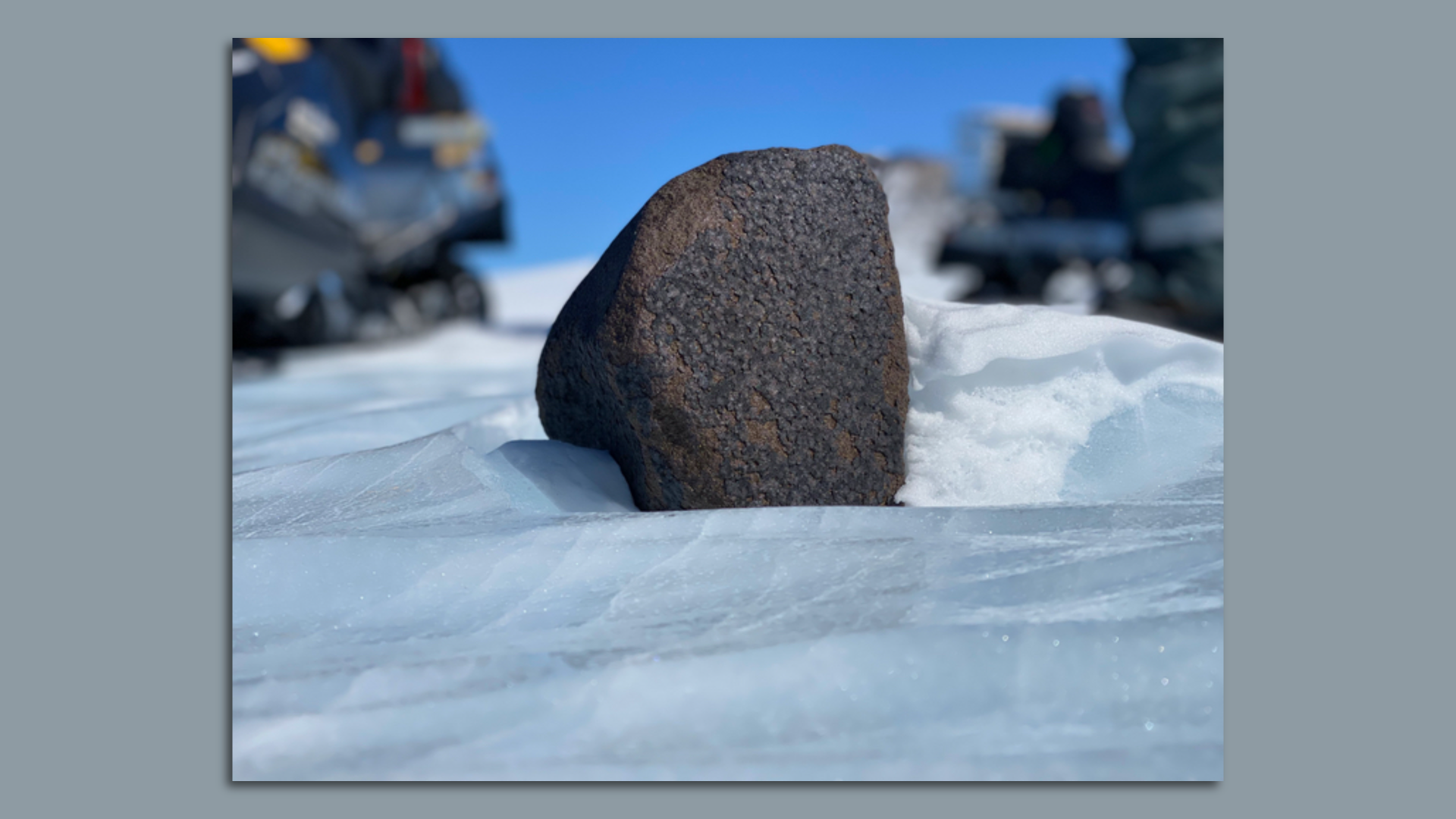| | | | | | | Presented By Advisor.com | | | | Axios Science | | By Alison Snyder · Jan 19, 2023 | | Thanks for reading Axios Science. This week's newsletter — coming to you from Davos, Switzerland, where my Axios colleagues and I are reporting from the World Economic Forum — is 1,457 words, about a 5-minute read. | | | | | | 1 big thing: Biology as power |  | | | Illustration: Aïda Amer/Axios | | | | DAVOS, Switzerland — The world is entering an era of biology — and the field's power is an emerging theme on the agenda of a cohort of scientists, entrepreneurs and business leaders at this week's World Economic Forum. The big picture: Scientific capability and prowess have been "a defining feature of power" over the past 100 years, Matthew McKnight, general manager of biosecurity at the synthetic biology company Ginkgo Bioworks told me on the sidelines of the annual event. - First, it was chemistry that created an economy fueled by petroleum.
- Next, physics was harnessed to build atomic weapons during World War II and then for the development of airplanes, communications and the space industry.
- Then, physics and chemistry together birthed the microchip and the computing revolution.
Now, it's biology. - Base pairs, amino acids, enzymes and other biological molecules underpin a vision for an economy built on biologically engineered and produced materials, medicines, fuel and food.
In Davos, biology was featured as a tool for addressing climate change: Loam, a startup based in Australia and the U.S., is leveraging microbes in soil to boost crop yields — and sequester carbon. They coat seeds with a fungus that makes forms of carbon that are stored in the soil for hundreds of years or more. - "I would love to get more people [at Davos] to think more creatively about how microbial science can help address climate change," says Loam's CEO and co-founder Guy Hudson.
In the public health sphere, Davos discussions focused on the need to spot new variants of the SARS-CoV-2 virus. - Ginkgo Bioworks is working with a Centers for Disease Control and Prevention (CDC) program at airports to try to spot virus subvariants as travelers enter the U.S.
- Passengers can volunteer to answer questions and provide a nasal swab. This week they announced a pilot program to monitor for influenza viruses as well, which could yield data to help scientists develop the vaccine for next year's flu season.
- Another arm of the program uses wastewater from airplane toilets to monitor pathogens, an inexpensive method honed during the pandemic.
"Radar" systems like these for infectious diseases, microbes and genetically altered threats can be part of a biosecurity infrastructure that could work like cybersecurity monitoring to find threats early, McKnight says. - "Biology doesn't respect borders," which underscores the need for a biology monitoring network, he says.
- The capability to monitor for biological threats could be a powerful national security tool and "important for the long-term biosecurity of our country," White House COVID-19 Response coordinator Ashish Jha told Politico.
What to watch: Science is an economic force but new science especially comes with a risk of being used for nefarious purposes. (A separate panel explored so-called dual-use technologies, which include pathogen-enhancing research and genome editing.) - Biology will be used offensively by bad actors, McKnight says. But leveraging biology for defensive capabilities is equally powerful, he adds.
|     | | | | | | 2. JWST is upending our understanding of the early universe |  | | | Photo illustration: Aïda Amer/Axios. Photo: NASA, ESA, CSA, and STScI | | | | The James Webb Space Telescope has been fully operational for less than a year, but its data is already hinting the early universe may have more galaxies — and more complicated galaxies — than many models have predicted, Axios' Miriam Kramer writes. Why it matters: A longstanding question in astronomy and astrophysics has centered on how the first generations of galaxies formed and evolved after the Big Bang. - The JWST was built, in part, to answer those questions.
- "I think we're really seeing the ultimate origins of humanity," astronomer Steven Finkelstein, of the University of Texas at Austin, tells Axios. "These early galaxies are the sites where the earliest stars formed. They formed the first heavy metals in the universe. Those heavy metals eventually became our Earth and our bodies."
What's happening: One study submitted to the Astrophysical Journal looked at 850 galaxies that formed between 11 billion and 13 billion years ago, grouping them according to type — spiral, elliptical, irregular or a combination. - The team found the proportion of galaxies by type was nearly the same as what they see in the nearby universe today. This could mean these galaxies were relatively far along in their evolution, despite the universe's young age.
- Another study published in the Astrophysical Journal in December found 87 galaxies that may have been around just 200 million to 400 million years after the Big Bang. This would be far more galaxies than scientists expected to see at this point in cosmic time.
- Even if only a relatively small number of those galaxies turn out to be real, astronomer Haojing Yan, one of the authors of the study said during a news conference last week, "then our previously-favored picture of galaxy formation in the early universe must be revised."
The intrigue: The evidence there may be more galaxies in the early universe doesn't necessarily mean there's something wrong with the prevailing model of how the universe works that predicts how many early galaxies astronomers should see, Finkelstein says. - But it does mean there's likely something about these early galaxies that needs to be re-examined.
- It could be that galaxies in these early eras of the universe were just brighter than initially expected, making it easier for scientists to see them in the data available now, Finkelstein says.
- Or, the stars forming in these galaxies might be hotter and brighter than expected, forming from metal-poor gas, which allows them to grow to massive sizes — and get hotter and brighter.
Read the entire story. |     | | | | | | 3. Parts of Greenland warmer now than in 1,000 years |  | | | An aerial view of meltwater on the Russell Glacier in Greenland on Aug. 16, 2022. Photo: Lukasz Larsson Warzecha/Getty Images | | | | Northern and central Greenland were warmer in the early 21st century compared to any period in at least the past 1,000 years, a new study found, Axios' Andrew Freedman writes. Why it matters: The new research offers the first conclusive evidence of human-induced long-term warming and increased meltwater runoff in the northern and central parts of Greenland, typically the coldest parts of the ice sheet. - How much and how fast the ice sheet melts will help determine the fate of coastal residents worldwide, given its contribution to sea level rise.
The big picture: The study, published in the journal Nature, finds that the warming during 2000-2011 exceeded the peak from swings in temperatures during pre-industrial times "with virtual certainty," and is about 1.5°C warmer than it was during the 20th century. - The likelihood that such temperatures would occur during the period from 1000-1800 is "close to zero," the paper states.
- The researchers worked to overcome a large amount of natural climate variability in the region by obtaining as many high-quality ice core and other climate records as possible.
Threat level: "Global warming is now detectable in one of the most remote regions of the world," the study states. - The reconstructed history of meltwater flowing off the ice sheet shows a spike during the 2000-2011 period that is unprecedented for the past millennium, a trend it predicts will continue, though with less certainty than the temperature conclusions.
What they're saying: "I hope this is a reminder for everyone that we should be worried, very worried about the Greenland ice sheet melting away," Eric Rignot of UC Irvine and a senior researcher at NASA, who was not involved in the study, tells Axios via email. - Ian Joughin, a climate scientist at the University of Washington, who was also not involved in the new work, said the study offers valuable new data. "Greenland is warming with a clear linear trend, which likely will steepen with time," he said.
Yes, but: Joughin cautioned that natural variability in the region means future decades could see lower amounts of warming and melting, at least temporarily. |     | | | | | | A message from Advisor.com | | Never make another financial decision alone | | |  | | | | We all have that sinking feeling we're missing out on opportunities with our money. Advisor.com offers expert financial planning and investing for a flat annual fee. Whether you have $0 or $1M in investments, you pay one rate for the same white glove service. Take our quiz to see if you need an advisor. | | | | | | 4. Worthy of your time | | The penguins' accidental hero (John Ridding — FT) How our microbiome is shaped by family, friends and even neighbors (Ewen Callaway — Nature) Next up for CRISPR: Gene editing for the masses? (Jessica Hamzelou — MIT Tech Review) |     | | | | | | 5. Something wondrous |  | | | The 17-pound meteorite. Photo: Courtesy of Maria Valdes/Field Museum and the University of Chicago | | | | A 16.7-pound meteorite has been collected by a team of scientists in Antarctica. Why it matters: Every meteorite matters to scientists. The relatively rare rocks carry important clues about the history of the solar system. - "Size doesn't necessarily matter when it comes to meteorites, and even tiny micrometeorites can be incredibly scientifically valuable," Maria Valdes, a member of the research team and a scientist at the Field Museum and the University of Chicago said in a news release.
- "But of course, finding a big meteorite like this one is rare, and really exciting."
How it works: The researchers used satellite imagery and a machine learning algorithm to map sites on Antarctica to search for meteorites. The snow and ice-covered continent is prime meteorite hunting habitat — the black meteorites stand out against the ice. - Antarctica's dry, cold climate also helps to preserve the meteorites.
- The nearly 17-pound find is one of five meteorites collected during the past month by the team that will be analyzed at the Royal Belgian Institute of Natural Sciences.
The big picture: Over the past century, approximately 45,000 meteorites have been found in Antarctica — and as many as 300,000 more meteorites might be there. |     | | | | | | A message from Advisor.com | | Never make another financial decision alone | | |  | | | | We all have that sinking feeling we're missing out on opportunities with our money. Advisor.com offers expert financial planning and investing for a flat annual fee. Whether you have $0 or $1M in investments, you pay one rate for the same white glove service. Take our quiz to see if you need an advisor. | | | | Big thanks to Laurin-Whitney Gottbrath for editing this edition, to Aïda Amer on the Axios Visuals team and to Carolyn DiPaolo for copy editing. |  | | Are you a fan of this email format? Your essential communications — to staff, clients and other stakeholders — can have the same style. Axios HQ, a powerful platform, will help you do it. | | | | | | Axios thanks our partners for supporting our newsletters.
Sponsorship has no influence on editorial content. Axios, 3100 Clarendon Blvd, Arlington VA 22201 | | | You received this email because you signed up for newsletters from Axios.
To stop receiving this newsletter, unsubscribe or manage your email preferences. | | | Was this email forwarded to you?
Sign up now to get Axios in your inbox. | | | | Follow Axios on social media:    | | | | | |









No comments:
Post a Comment